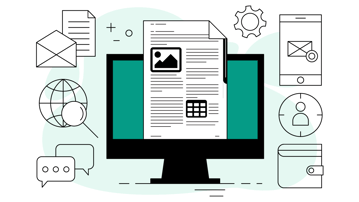The internet, personal computer, and email have revolutionized the way we work proposals. We no longer have to wait to access and share information, making team communication a lot less time-consuming and frustrating. Some proposal things, however, remain the same:
Set-Up Your Compliance Matrix
The matrix is your first step to building a comprehensive proposal content plan which will drive roles, tasks, and timeline.
It helps you, and your team, untangle requirements that affect various sections, figure out where to address them in the proposal, and understand and validate compliance requirements are addressed and met.
• What requirements must be addressed in each section?
• What requirements must be addressed across different sections?
• Validate that all requirements have been addressed in each section.
• Validate that all requirements have been addressed across sections.
The matrix is a simple table or spreadsheet; each RFP section gets a column, and each row links each proposal section with one or more requirements.
Outline the Proposal and Annotate Tasks
Proposals are persuasive documents; structured logical written arguments that lay out everything in favor of your solution. Most teams rely on their subject matter experts - who are more used to writing materials that inform and explain, such documentation or training materials, rather than persuade.
Outlining and annotating your proposal for your experts gives them the direction and details they need to write persuasively and reduce revisions.
Whether you outline and annotate every chapter down to the last detail, or just provide a few notes on win themes and discriminators, it will give your experts a sense of direction and an idea of what you expect during reviews.
Suggested content



Clearly Define Roles and Tasks
Defining roles, responsibilities, and tasks up front will set the team’ s expectations, establish trust, and help keep the chaos to a minimum.
Prior to the Kick-Off Meeting, set a meeting with the executive team and appropriate managers to establish roles, responsibilities, and tasks. They will know who has the expertise and who is available. They will help you staff the proposal so you can establish the schedule and clear the way for the Kick-off.
Build Your Calendar Roadmap
Centralizing tasks, milestones, and deadlines is a great way to get your team on the same page, and establish priorities. Nobody wants to waste time digging through email to find the latest version of a spreadsheet. People are just more likely to step up when they understand where their piece of the puzzle fits in the big picture. And they’re more likely to carve out time when they have one, up-to-date place to view, sort by priority, and access their task documents.
Use Visuals to Tell Your Story
Think about your audience. When they are evaluating your proposal, they’re time is spread thin. Even the most engaged reader’s mind will wander when they read pages and pages of text, no matter how compelling. They know what’s coming – long pages of text and they’re not excited. Done right and when fully supported by the text proposal visuals are 38% more likely to be remembered by evaluators.
Remember, a well-structured proposal is not just a document; it's a strategic tool that can help you achieve your business objectives.









